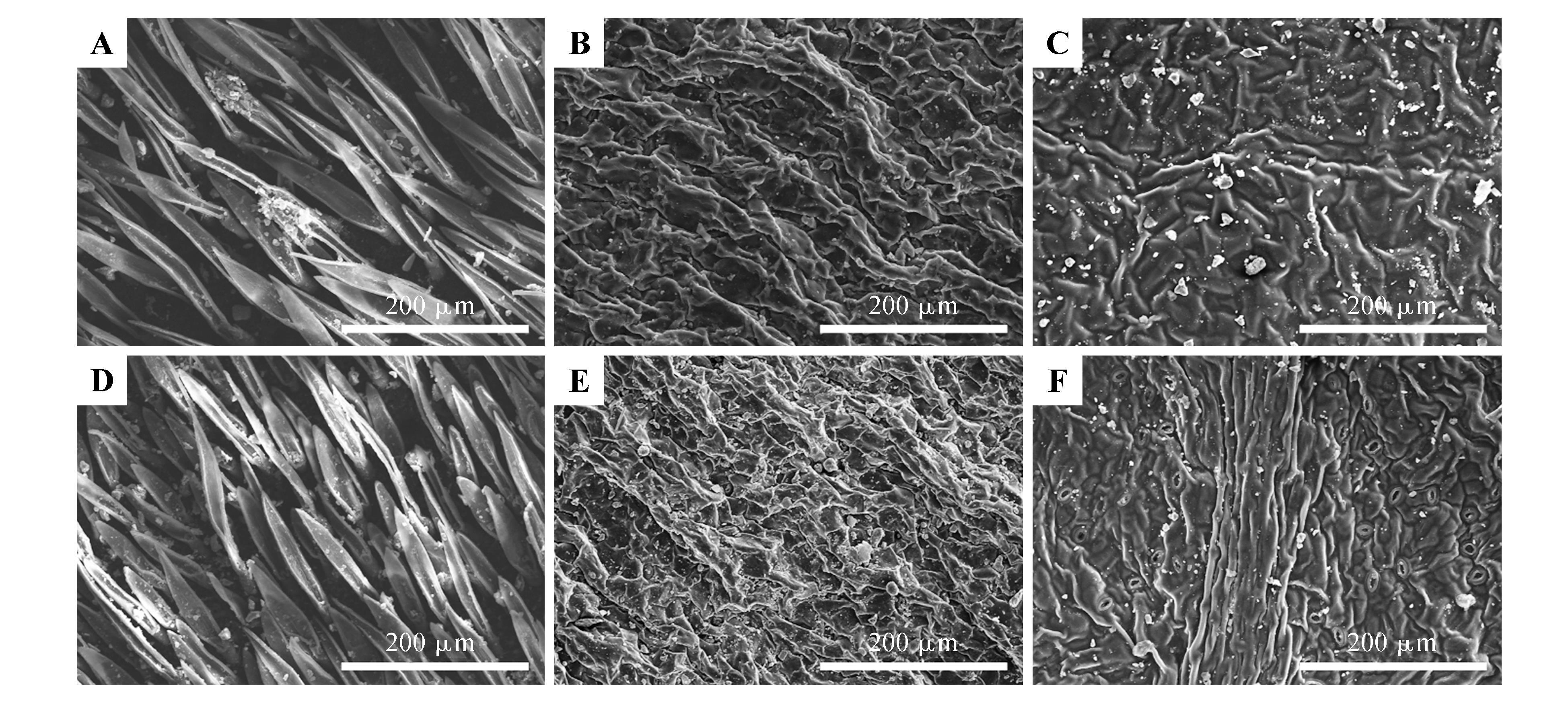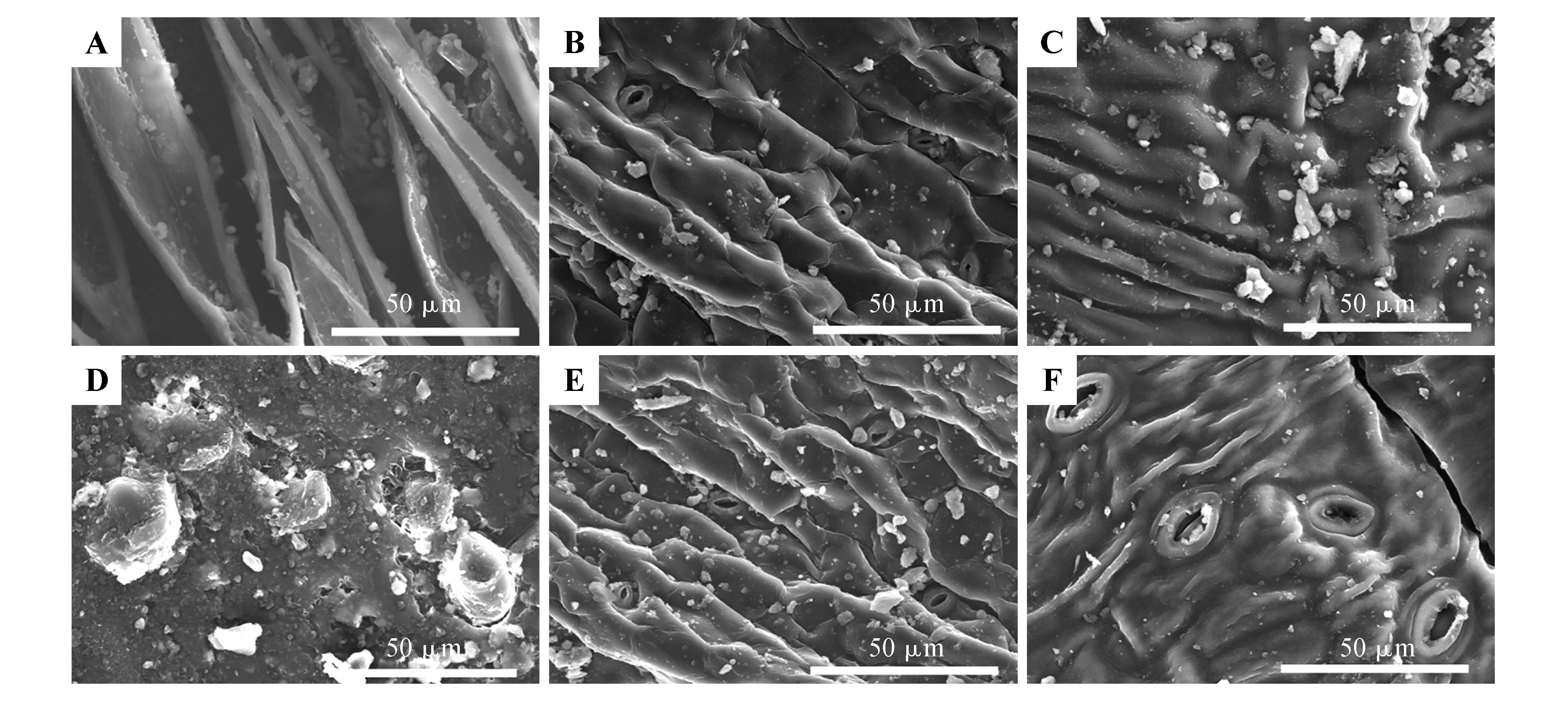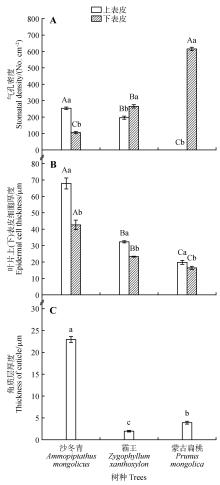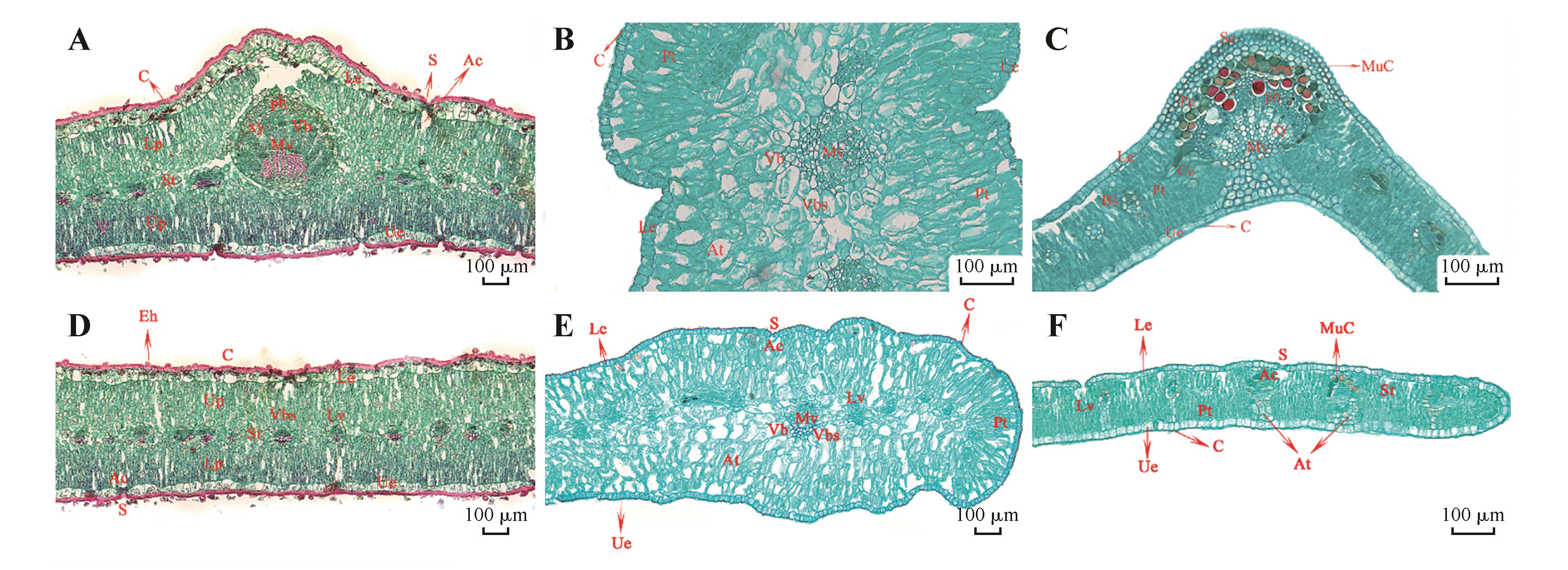Bulletin of Botanical Research ›› 2024, Vol. 44 ›› Issue (4): 612-624.doi: 10.7525/j.issn.1673-5102.2024.04.013
• Physiology and Ecology • Previous Articles
Yaowen SUN1, Yingmei MA1( ), Xiaomin REN2, Feng HAN2, Xin CHEN1, Lang ZUO1
), Xiaomin REN2, Feng HAN2, Xin CHEN1, Lang ZUO1
Received:2023-12-15
Online:2024-07-20
Published:2024-07-09
Contact:
Yingmei MA
E-mail:mym_youxiang@sina.com
CLC Number:
Yaowen SUN, Yingmei MA, Xiaomin REN, Feng HAN, Xin CHEN, Lang ZUO. Ecological Adaptability of Three Native Tree Species after Artificial Cultivation in Desert Area of Hetao Plain[J]. Bulletin of Botanical Research, 2024, 44(4): 612-624.
Add to citation manager EndNote|Ris|BibTeX
URL: https://bbr.nefu.edu.cn/EN/10.7525/j.issn.1673-5102.2024.04.013

Fig.3
Leaf epidermal structure characteristics of three plantsA.Adaxial surface of Ammopiptanthusmongolicus leaves;B.Adaxial surface of Zygophyllum xanthoxylon leaves;C.Adaxial surface of Prunus mongolica leaves;D.Adaxial surface of Ammopiptanthus mongolicus leaves;E.Abaxial surface of the Zygophyllum xanthoxylon leaves;F.Abaxial surface of Prunus mongolica leaves.


Fig.4
Distribution and morphological characteristics of epidermal hairs and stomata in leaves of three plantsA.Adaxial surface of Ammopiptanthusmongolicus leaves;B.Adaxial surface of Zygophyllum xanthoxylon leaves;C.Adaxial surface of Prunus mongolica leaves;D.Adaxial surface of Ammopiptanthus mongolicus leaves;E.Abaxial surface of the Zygophyllum xanthoxylon leaves;F.Abaxial surface of Prunus mongolica leaves.


Fig.5
Comparison of anatomical characteristics of three plant leavesDifferent capital letters indicate the same index,and different plant species exhibit significant differences at the P<0.05 level;different lowercase letters indicate significant differences within the same plant species for different indicators at the P<0.05 level.


Fig.6
Structural characteristics of leaf transverse sectionA,D.Ammopiptathus mongolicus;B,E.Zygophyllum xanthoxylon;C,F.Prunus mongolica;Ue.Upper epidermis cell;Le.Lower epidermis cell;Up.Upper palisade tissue;Lp.Lower palisade tissue;Mv.Main vein;St.Spongy tissue;Ac.Air chamber;Sc.Stratum corneum;S.Stomatal apparatus;Pt.Palisade tissue;At.Aquiferous tissue;Vb.Vascular bundle;Vbs.Vascular bundle cells;Xy.Xylem;Ph.Phloem;Bs.Bundle sheath;Cc.Crystal cell;MuC.Mucilage cell; Sc.Sclerenchyma cell;Pc.Parenchymal cells.

| 1 | 何磊.基于遥感方法的阿拉善盟荒漠化研究[D].兰州:兰州大学,2013. |
| HE L.Study on desertification in Alxa league based on remote sensing method[D].Lanzhou:Lanzhou university,2013. | |
| 2 | 王涛.干旱区绿洲化、荒漠化研究的进展与趋势[J].中国沙漠,2009,29(1):1-9. |
| WANG T.Review and prospect of research on oasification and desertification in arid regions[J].Journal of Desert Research,2009,29(1):1-9. | |
| 3 | 解李娜,吴祺琪,王宇萌,等.锦鸡儿属灌木阻止干旱草地沙漠化生态过程[J].生态学报,2024,44(4):1680-1691. |
| XIE L N, WU Q Q, WANG Y M,et al.Ecological processes of preventing arid grasslands from changing into deserts by Caragana shrubs[J].Acta Ecologica Sinica,2024,44(4):1680-1691. | |
| 4 | 甘开元,张金霞,陈丽娟,等.乌兰布和沙漠沿黄河段植物群落特征及空间分异[J].中国沙漠,2023,43(4):180-190. |
| GAN K Y, ZHANG J X, CHEN L J. et al.Characteristics and spatial differentiation of plant communities along the Yellow River in the Ulan Buh Desert[J].Journal of Desert Research,2023,43(4):180-190. | |
| 5 | 黄雅茹,马迎宾,张景波,等.乌兰布和沙漠东北缘小胡杨叶功能性状特征[J].科技导报,2023,41(18):92-100. |
| HUANG Y R, MA Y B, ZHANG J B,et al.Characteristics of leaf functional traits of Populus simonii×P.euphratica on the northeastern edge of Ulanbuh Desert[J].Science & Technology Review,2023,41(18):92-100. | |
| 6 | 杨晓娟,廖超英,孙文艳,等.乌兰布和沙漠东北部沙区人工林土壤肥力质量评价[J].干旱区研究,2012,29(4):604-608. |
| YANG X J, LIAO C Y, SUN W Y,et al.Assessment on soil fertility of planted forests in the northeast sandy area of the Ulanbuh Desert[J].Arid Zone Research,2012,29(4):604-608. | |
| 7 | 李亮,包耀贤,廖超英,等.乌兰布和沙漠东北部沙区人工林土壤微生物及酶活性研究[J].西北植物学报,2010,30(5):987-994. |
| LI L, BAO Y X, LIAO C Y,et al.Soil microorganism and enzyme activities under different artificial forests in the northeast of Ulanbuh Desert[J].Acta Botanica Boreali-Occidentalia Sinica,2010,30(5):987-994. | |
| 8 | 郝玉光,丁国栋,张景波,等.乌兰布和沙漠东北缘防护林体系建设对风沙灾害性天气影响的数量化研究[J].中国水土保持科学,2004,2(1):79-82. |
| HAO Y G, DING G D, ZHANG J B,et al.Study on the quantitative relationship between the sand-wind disastrous climate and the construction of the protecting forest system on the northeast edge of Wulanbuh Desert[J].Science of Soil and Water Conservation,2004,2(1):79-82. | |
| 9 | 李慧卿.乌兰布和沙漠东缘固沙植被恢复重建与资源利用中的几个问题分析[J].生态学杂志,2004,23(6):182-185. |
| LI H Q.Problems in the process of sand fixing vegetation restoration and resource utilization in Ulanbuhe desert[J].Chinese Journal of Ecology,2004,23(6):182-185. | |
| 10 | 乌拉.乌兰布和沙漠植被及其保护[J].陕西林业科技,2007(4):133-137. |
| WU L.Desert vegetation in Wulanbuhe and protection measures[J].Shaanxi Forest Science and Technology,2007(4):133-137. | |
| 11 | 徐恒刚.内蒙古西部沙区荒漠灌丛植被及沙区生态建设[M].北京:中国农业科学技术出版社,2005. |
| XU H G.Desert shrub vegetation and ecological construction in sandy area of western Inner Mongolia[M].Beijing:China Agricultural Science and Technology Press,2005. | |
| 12 | 高国雄.毛乌素沙地东南缘人工植被结构与生态功能研究[D].北京:北京林业大学,2007. |
| GAO G X.Study on structure and ecological function of artificial vegetation in southeastern margin of Maowusu sand land[D].Beijing:Beijing Forestry University,2017. | |
| 13 | 周瑞莲,赵哈林,王海鸥.科尔沁沙地植物演替的生理机制[J].干旱区研究,2001,18(3):13-19. |
| ZHOU R L, ZHAO H L, WANG H O.Physiological mechanism of succession of the plants in Horqin Sandland,China[J].Arid Zone Research,2001,18(3):13-19. | |
| 14 | 周瑞莲,孙国钧,王海鸥.沙生植物渗透调节物对干旱、高温的响应及其在抗逆性中的作用[J].中国沙漠,1999,19():19-23. |
| ZHOU R L, SUN G J, WANG H O.Osmoregulation changes in desert plants under drought and high temperature stresses,related to their resistance[J].Journal of Desert Research,1999,19(Sup):19-23. | |
| 15 | 孙梅,田昆,张贇,等.植物叶片功能性状及其环境适应研究[J].植物科学学报,2017,35(6):940-949. |
| SUN M, TIAN K, ZHANG Y,et al.Research on leaf functional traits and their environmental adaptation[J].Plant Science Journal,2017,35(6):940-949. | |
| 16 | CHITWOOD D H, SINHA N R.Evolutionary and environmental forces sculpting leaf development[J].Current Biology,2016,26(7):R297-R306. |
| 17 | 周瑞莲,侯玉平,左进城,等.不同沙地共有种沙生植物对环境的生理适应机理[J].生态学报,2015,35(2):340-349. |
| ZHOU R L, HOU Y P, ZUO J C,et al.The physiological adaptation mechanisms of four common desert species in response to desert environments[J].Acta Ecologica Sinica,2015,35(2):340-349. | |
| 18 | 黄振英,吴鸿,胡正海.30种新疆沙生植物的结构及其对沙漠环境的适应[J].植物生态学报,1997,21(6):521-530. |
| HUANG Z Y, WU H, HU Z H.The structures of 30 species of psammophytes and their adaptation to the sandy desert environment in Xinjiang[J].Chinese Journal of Plant Ecology,1997,21(6):521-530. | |
| 19 | 刘玉冰,李新荣,李蒙蒙,等.中国干旱半干旱区荒漠植物叶片(或同化枝)表皮微形态特征[J].植物生态学报,2016,40(11):1189-1207. |
| LIU Y B, LI X R, LI M M,et al.Leaf (or assimilation branch) epidermal micromorphology of desert plant in arid and semi-arid areas of China[J].Chinese Journal of Plant Ecology,2016,40(11):1189-1207. | |
| 20 | 陈成升,谢志霞,刘小京,等.等渗盐分、干旱胁迫下冬小麦叶片部分渗透调节物质的动态变化[J].植物研究,2009,29(6):708-713. |
| CHEN C S, XIE Z X, LIU X J,et al.Dynamic transformation of the substances of osmotic adjustment in winter wheat under iso-osmotic salt and drought stresses[J].Bulletin of Botanical Research,2009,29(6):708-713. | |
| 21 | LI J, XIE J M, YU J H,et al.Melatonin enhanced low-temperature combined with low-light tolerance of pepper (Capsicum annuum L.) seedlings by regulating root growth,antioxidant defense system,and osmotic adjustment[J].Frontiers in Plant Science,2022,13:998293. |
| 22 | YOSHIBA Y, KIYOSUE T, NAKASHIMA K,et al.Regulation of levels of proline as an osmolyte in plants under water stress[J].Plant and Cell Physiology,1997,38(10):1095-1102. |
| 23 | MADAN S, NAINAWATEE H S, JAIN S,et al.Leaf position-dependent changes in proline,pyrroline-5-carboxylate reductase activity and water relations under salt-stress in genetically stable salt-tolerant somaclones of Brassica juncea L.[J].Plant and Soil,1994,163(2):151-156. |
| 24 | 周恒,谢彦杰.植物氧化胁迫信号应答的研究进展[J].生物技术通报,2023,39(11):36-43. |
| ZHOU H, XIE Y J.Recent progress in oxidative stress signaling and response in plants[J].Biotechnology Bulletin,2023,39(11):36-43. | |
| 25 | 陈少裕.膜脂过氧化对植物细胞的伤害[J].植物生理学通讯,1991(2):84-90. |
| CHEN S Y.Injury of membrane lipid peroxidation to plant cell[J].Plant Physiology Communications,1991(2):84-90. | |
| 26 | 王艳萍,刘胜利,陈玉珍,等.3种长白山高山杜鹃叶片结构及其对环境的适应性[J].北京林业大学学报,2012,34(4):18-25. |
| WANG Y P, LIU S L, CHEN Y Z,et al.Leaf structural characteristics of three wild Rhododendron plants and their adaptability to Changbai Mountains,northeastern China[J].Journal of Beijing Forestry University,2012,34(4):18-25. | |
| 27 | 张志良.植物生理学实验指导[M].北京:高等教育出版社,2003. |
| ZHANG Z L.Experimental guidance of plant physiology[M].Beijing:Higher Education Press,2003. | |
| 28 | 王学奎.植物生理生化实验原理和技术[M].北京:高等教育出版社,2006. |
| WANG X K.Principles and techniques of plant physiological and biochemical experiments[M].Beijing:Higher Education Press,2006. | |
| 29 | 邹琦.植物生理生化实验指导[M].北京:中国农业出版社,1995. |
| ZOU Q.Plant physiological and biochemical experimental guidance [M].Beijing:China Agricultural Publishing House,1995. | |
| 30 | 郭丽红.植物生理生化[M].成都:电子科技大学出版社,2020. |
| GUO L H.Plant physiological and biochemical experimental guidance[M].Chengdu:University of Electronic Science and Technology Press,2020. | |
| 31 | 罗凤敏,高君亮,辛智鸣,等.乌兰布和沙漠东北缘起沙风风况及输沙特征[J].农业工程学报,2019,35(4):145-152. |
| LUO F M, GAO J L, XIN Z M,et al.Characteristics of sand-driving wind regime and sediment transport in northeast edge of Ulan Buh Desert[J].Transactions of the Chinese Society of Agricultural Engineering,2019,35(4):145-152. | |
| 32 | 吴正.风沙地貌学[M].北京:科学出版社,1987. |
| WU Z.Aeolian geomorphology[M].Beijing:Science Press,1987. | |
| 33 | BLILOU I, HIRT H.Desert plants to stop desertification:to succeed,reforestation projects to reclaim once fertile lands need to consider the local abiotic,biotic,and social factors[J].EMBO Reports,2022,24(2):e56687. |
| 34 | AKRAM M A, ZHANG Y H, WANG X T,et al.Phylogenetic independence in the variations in leaf functional traits among different plant life forms in an arid environment[J].Journal of Plant Physiology,2022,272:153671. |
| 35 | HERNANDEZ J O, PARK B B.The leaf trichome,venation,and mesophyll structural traits play important roles in the physiological responses of oak seedlings to water-deficit stress[J].International Journal of Molecular Sciences,2022,23(15):8640. |
| 36 | BILKOVA I, KJAER A, VAN DER KOOY F,et al.Effects of N fertilization on trichome density,leaf size and artemisinin production in Artemisia annua leaves[J].Acta Horticulturae,2014,1125:369-375. |
| 37 | 金雅琴,李冬林.遮光对红果榆幼苗光合作用及叶片解剖结构的影响[J].西北植物学报,2023,43(6):1006-1016. |
| JIN Y Q, LI D L.Effects of shading on photosynthetic characteristics and leaf anatomical structure of Ulmus szechuanica seedlings[J].Acta Botanica Boreali-Occidentalia Sinica,2023,43(6):1006-1016. | |
| 38 | 曹林青,钟秋平,邹玉玲,等.油桐种质资源叶片结构变异及与环境因子的关系[J].南京林业大学学报(自然科学版),2023,47(4):95-102. |
| CAO L Q, ZHONG Q P, ZOU Y L,et al.Leaf structure variations and relationship with environmental factors among germplasm resources of Vernicia fordii [J].Journal of Nanjing Forestry University (Natural Sciences Edition),2023,47(4):95-102. | |
| 39 | 赵霖玉,李秧秧.遮阴和干旱对白桦幼苗光诱导的气孔动力学影响[J].应用生态学报,2022,33(9):2331-2338. |
| ZHAO L Y, LI Y Y.Effects of shading and drought on light-induced stomatal dynamics in Betula platyphylla seedlings[J].Chinese Journal of Applied Ecology,2022,33(9):2331-2338. | |
| 40 | 赵杏花,李旭红,郭璐,等.唐古特白刺叶片形态结构的地域环境分异[J].干旱区资源与环境,2020,34(9):143-150. |
| ZHAO X H, LI X H, GUO L,et al.Regional and environmental differentiation of leaf morphology and anatomical structure of Nitraria tangutorum [J].Journal of Arid Land Resources and Environment,2020,34(9):143-150. | |
| 41 | 何永涛,胡宇,段慧荣,等.我国披碱草属植物抗逆性评价指标研究进展[J].中国草地学报,2022,44(8):96-108. |
| HE Y T, HU Y, DAUN H R,et al.Advance of evaluation indexes on stress resistance of Elymus plants in China[J].Chinese Journal of Grassland,2022,44(8):96-108. | |
| 42 | 秦立刚,李雪,李韦瑶,等.PEG干旱胁迫对3种葱属植物种子萌发期渗透调节物质及酶活性的影响[J].草地学报,2021,29(1):72-79. |
| QIN L G, LI X, LI W Y,et al.Effects of PEG stress on osmotic regulation substances and enzyme activities during seed germination of three Allium L.[J].Acta Agrestia Sinica,2021,29(1):72-79. |
| [1] | Shuanglong TANG, Shixin CHEN, Yu WANG, Danwei MA, Shihui YANG, Shenming NIE, Zhaxizeli, Zhengyou TIAN. Morphological Adaptation to Alpine Environment of a Chinese Endemic Species, Cynanchum forrestii [J]. Bulletin of Botanical Research, 2024, 44(3): 389-399. |
| [2] | Huiling YAN, Xinxin ZHANG, Xiyang ZHAO, Guanzheng QU, Zhaoning WANG, Rui HAN. Effects of Light Signal on Anthocyanin Biosynthesis and Gene Expression of AmRosea1 Overexpressed 84K Poplar [J]. Bulletin of Botanical Research, 2023, 43(6): 815-825. |
| [3] | Chaoyang MA, Tianfeng LIU, Xiaoxue LI, Cancan HUO, Lingling FU, Zailiu LI. Interannual Changes in the Effects of Soil Gravel Content on the Growth and Physiology of Handeliodendron bodinieri Seedlings [J]. Bulletin of Botanical Research, 2023, 43(6): 890-899. |
| [4] | Shuyao ZHUANG, Hengbo XU, Xiaoyu HU, Shang DAI, Yanni ZHANG. Effects of Saline-alkali Stress on Growth and Physiological Characteristics of Color Leaf Heuchera micrantha ‘Silver Fan’ Seedlings [J]. Bulletin of Botanical Research, 2023, 43(4): 520-530. |
| [5] | Ying KANG, Jingjing PAN, Jianhua CHEN, Quangang LIU, Shengjun DONG. Contents of Pigments and Anatomical Structure of Leaves in Acer negundo ‘Aurea’ [J]. Bulletin of Botanical Research, 2023, 43(4): 591-600. |
| [6] | Qingsong WU, Yinghui LIU, Shuo LI, Panpan LI, Youmin ZHANG. Anatomical Structure and Ecological Adaptability of Stems and Leaves of Rhamnus ussuriensis [J]. Bulletin of Botanical Research, 2023, 43(3): 461-469. |
| [7] | Zhihui HUANG, Yining ZHANG, Nana LI, Baojiang ZHENG, Yuhong ZHANG. Responses of Supplemental UV-B Radiation to Physiological Properties and Secondary Metabolites of Thlaspi arvense [J]. Bulletin of Botanical Research, 2022, 42(6): 1079-1087. |
| [8] | Xiaolu CAO, Qiaozhu ZHAO, Hua XING, Mengfei LI. Anatomical Structure of Seed and Morphological Character at Different Germination Stages of Sinopodophyllum hexandrum [J]. Bulletin of Botanical Research, 2022, 42(5): 746-752. |
| [9] | Weiwei ZHUANG, Mingming WANG. Comparative Analysis of Nutrient Elements of Eight Herbaceous Plants in Desert Area [J]. Bulletin of Botanical Research, 2022, 42(5): 896-909. |
| [10] | Kailin Zhu, Jiabao Li, Xin Chen. Leaf Anatomical Characteristics and Environmental Adaptability of Seven Sorbus Species at Longcanggou National Forest Park [J]. Bulletin of Botanical Research, 2022, 42(2): 174-183. |
| [11] | Sen SHI, Na MIAO, Yu-Tong SHI, Hui-Mei WANG. Effects of Sucrose on Growth and Physiological Characteristics in vitro Plantlets of 84K Poplar [J]. Bulletin of Botanical Research, 2021, 41(1): 74-78. |
| [12] | LI Dong-Lin, JIN Ya-Qin, CUI Meng-Fan, HUANG Lin-Xi, PEI Wen-Hui. Effects of Shading on Physiological Characteristics and Ultrastructure of Mesophyll Cell of Emmenopterys henryi Leaves [J]. Bulletin of Botanical Research, 2020, 40(1): 29-40. |
| [13] | JI Li, HAN Jiao, WANG Fang, WANG Jun, SONG Di, ZHANG Li-Jie, QI Yong-Hui, YANG Yu-Chun. Effects of Drought Stress on Photosynthetic and Physiological Characteristics of Juglans mandshurica Seedlings in Different Soil Substrates [J]. Bulletin of Botanical Research, 2019, 39(5): 722-732. |
| [14] | HU Ju-Wei, DAI Xin, SONG Tao, SUN Guang-Yu. Effects of Different Light Qualities on Growth and Photosynthetic Characteristics of Mulberry Seedlings [J]. Bulletin of Botanical Research, 2019, 39(4): 481-489. |
| [15] | XIE Zhi-Yu, ZHANG Wen-Hui, WEI Yong-Tao. Morphological Variations and Physiological Characteristics of Phragmites australis in Three Habitats in Yellow River Delta [J]. Bulletin of Botanical Research, 2019, 39(3): 372-379. |
| Viewed | ||||||
|
Full text |
|
|||||
|
Abstract |
|
|||||